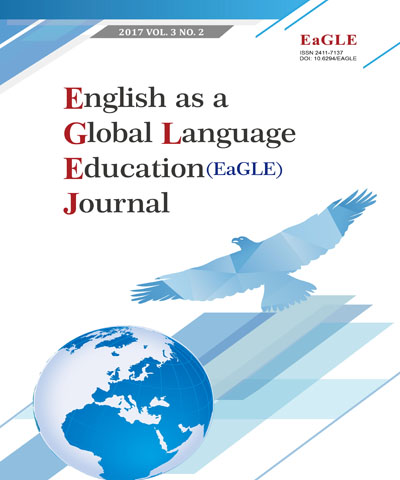
English as a Global Language Education (EaGLE) Journal
國立成功大學外語中心,停刊
選擇卷期
- 期刊
English as an international language (EIL) is a phenomenon growing out of globalization and communication in international contexts. English teachers inevitably have to respond to this shift of societal expectations and student needs. Traditionally, English has been taught and learned as a subject in schools in Taiwan. Nowadays EIL and its implications for English language teaching and learning are being increasingly noted and discussed. Efforts have also been made to update English educators' knowledge and sensitivity of using English for international communication, as well as pedagogical implications of EIL. This study examines if or how such endeavors have taken effect. More specifically, this study aims to find out: I) Are university students and non-native English speaking teachers in Taiwan aware of the development of EIL and its related pedagogical matters, namely the purpose of learning English, the definition of successful English learning, preferences for teachers' backgrounds, and preferences for writers and publishers of English materials? 2) Are the perceptions of EIL of students and instructors similar or different? What are the possible causes for the similarities and differences in their perceptions? Four classes of university students majoring in English (from freshmen to senior levels) and their non-native English-speaking teachers participated in the study. Questionnaires and interviews were conducted and results analyzed. Based on findings, professional considerations and classroom practicability for implementing EIL are then discussed.
- 期刊
The Internet constitutes a major context for the progressive evolution of intercultural communication in English as a lingua franca (ELF). Nevertheless, our understanding of how ELF speakers interact in cyberspace is limited. This study, drawing on data consisting of 85 conversation extracts from synchronous video chat discussions, investigates how Japanese and Taiwanese university students interact and communicate when they engage in cross-cultural exchanges online. This study reveals that the use of linguistic, pragmatic, cultural, and technological resources constitutes a powerful mechanism allowing interlocutors not only to tackle the obstacles they encounter but also to engage in the interpersonal dynamics of a conversation in a multifaceted fashion; that is, these resources shape and open up modes of interaction as well as fostering communicative success. As shown by the analysis, contextual variables such as educational goals, institutional support, learner identities, and communication technology have mediating effects on the way in which ELF operates. ELF's inherent hybridity, fluidity, and variety account for not only the features of language contact across geographical borders but also for the impacts of the contexts of interaction. The implications of the findings for ELF teaching and learning in the digital world are offered and discussed.
- 期刊
English is being used as the medium of instruction in an increasing number and range of courses, programs and universities. It is therefore crucial that both teachers and students can deal with the demands that such a study environment places upon them in order to maintain the same quality of education. Such demands include issues of processing the content and learning materials, and interacting with classmates and instructors in English. This article discusses how integrating content and language teaching (ICL) could be one way to address some of these challenges. ICL is defined in this context as content and language teachers working together on the same course. One example is given of the electrical engineering program at a technical university where content and language are integrated throughout the program in order to provide the students with the skills required both by the EMI university environment but also by the workplace of today. Factors in designing such courses are discussed such as the learning objectives of the program; integrated activities; deep approaches to learning; formative feedback over summative feedback; and peer learning. It is argued that the collaboration between the "outsider" (the language teacher) and the "insider" (the content teacher) provide the former with an insight into the demands of the discipline on the student and the latter with an increased awareness of academic literacies.
- 期刊
This study examined two writing teachers' beliefs, perceived and actual practices related to written corrective feedback (WCF) in two English for Specific Purposes (ESP) writing classes in Taiwan. The researcher observed the in-class instruction of both writing teachers, employed interviews and questionnaires to explore factors influencing their WCF beliefs and perceptions, and checked their perceptions against their practices regarding WCF focus and approach through textual analyses. The results show that the writing instruction, the specific writing task, students' English proficiency levels, and the teachers' perceptions of their roles interacted to shape and reinforce both teachers' beliefs about WCF. Both teachers considered providing WCF to students their moral responsibility as an EFL and ESP teacher. The specific writing tasks requiring language precision also reinforced their beliefs about WCF. Their practices, in general, matched their beliefs and perceptions. The researcher suggests that more studies of writing teacher's beliefs about WCF be situated in an actual classroom context where writing instruction, tasks, and student proficiency levels interact to shape writing instructors' realistic beliefs about WCF. The researcher also suggests an alternative instructional perspective on assisting writing instructors in selecting the focus of their WCF in addition to the existing linguistic (i.e., rule-governed errors) and individual considerations.

